With its lively community spirit and rich blend of cultures, New Orleans embodies the true joys of life—great food, good drinks, and endless celebrations.

Framed by live oaks, Spanish moss, and lazy bayous, City Park is a breathtaking showcase of urban green space—stretching three miles long and one mile wide. Bigger than Central Park in New York, this local treasure is home to winding waterways, charming bridges, lush gardens, and one of the finest art museums in the South.
At its heart, City Park is less a manicured park and more a lightly tamed slice of Louisiana’s natural wetlands. Bayou Metairie snakes through the grounds, connecting pockets of forest and curated beauty. While golf courses slightly interrupt the wilderness vibe, there’s still enough untamed nature to wander and lose yourself in.
Art and nature enthusiasts could easily spend a full day here. Start at the New Orleans Museum of Art, a stately institution that features a strong collection of regional and American artists alongside works by masters like Edgar Degas. Adjacent to the museum is the Sydney & Walda Besthoff Sculpture Garden, where over 60 contemporary works—including George Rodrigue’s colorful Blue Dogs—dot five acres of landscaped grounds.
Nearby, the Botanical Garden offers a vibrant mix of global flora and local plants, making it a favorite setting for weddings and serene strolls. Overlooking Bayou Metairie is the Peristyle, a grand Ionic-columned pavilion from 1907, guarded by four noble concrete lions.
If you’re visiting with children, Carousel Gardens Amusement Park is a must. Its antique carousel, restored in the 1980s with the help of local fundraising, spins beneath a 1906 stained-glass cupola and retains its old-school charm. The area also features a miniature railroad, bumper cars, a tilt-a-whirl, and a petite Ferris wheel.
For more whimsical fun, Storyland brings fairy tales to life with colorful, Mardi Gras float-style statues crafted by legendary float-builder Blaine Kern. During the holidays, the whole space glows with festive lights, adding a touch of magic.
Another kid-friendly highlight is the Louisiana Children’s Museum, now located within the park. Designed as an educational play space, it includes giant bubble stations, mini construction sites, pretend grocery stores, a “book forest,” and more—all geared toward children under 10.
For a deeper dive into nature, Couturie Forest is the park’s most rugged area—a hardwood forest where trails meander through live oaks and underbrush, and the occasional mushroom peeks through the soil. Just park at the Harrison Avenue traffic circle, follow the road, and wander through the quiet woods.
Another hidden gem is the Popp Fountain, an elegant WPA-era structure surrounded by Corinthian columns and perennial gardens. The central fountain features bronze dolphins leaping through arcs of water, adding a classical flair.
City Park stands on the former site of the Allard Plantation. Much of its layout, from bridges and paths to Art Deco flourishes, was shaped during the Great Depression by the Works Progress Administration (WPA). The park’s ancient trees include thousands of majestic live oaks—some over 600 years old—as well as bald cypresses and Southern magnolias.
During Hurricane Katrina, floodwaters submerged 90% of the park, reaching depths of 8 feet in some areas. While many trees were lost, the park has rebounded. One beloved survivor is the Singing Oak, adorned with massive wind chimes up to 14 feet long. Standing beneath it on a breezy day is an enchanting experience.
Best parking spots: Near the New Orleans Museum of Art and the Morning Call Café.
Watch out for gators: While rare, alligators do inhabit the park’s waterways. Keep dogs on leashes and avoid swimming.
Morning Call (open 24/7) is perfect for coffee, beignets, or a casual meal.
Planning a picnic? Grab a hot lunch or sandwiches from Canseco’s on Esplanade Avenue.
City Park is more than just a green space—it’s a living, breathing extension of New Orleans itself: bold, artistic, a little wild, and completely unforgettable.
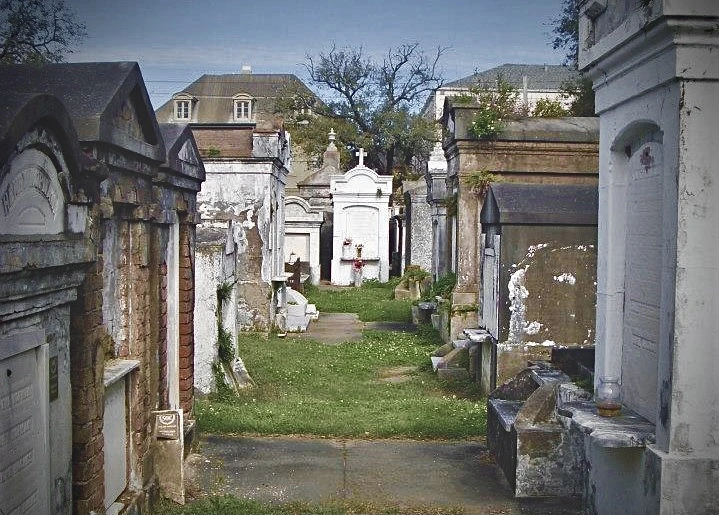
Among New Orleans’ many cemeteries, none capture the haunting allure of Southern Gothic quite like Lafayette Cemetery No. 1. Tucked away in the Garden District, it offers a jarring yet poetic contrast—crumbling crypts and quiet decay entwined with the wild, persistent growth of subtropical greenery. Every weathered tomb whispers a story—from German and Irish immigrants to yellow fever victims and fraternal orders that cared for their dead—inviting visitors into the city’s long, complex past.
The cemetery is laid out in the form of a cross, with two footpaths dividing its grounds. As you explore, you’ll find large communal tombs built by organizations like the Jefferson Fire Company No. 22, who cared for their members in life and death. The wealthier families commissioned elaborate marble tombs with striking architectural details, while others opted for simpler plastered brick structures, many of which are now softened by time and moss.
Founded in 1833 by the former City of Lafayette, the cemetery quickly filled, even before the neighborhood around it flourished. One of the tombs near the entrance holds an entire family lost to yellow fever—one of many such stories etched into these sacred grounds. By the 1870s, as affluence grew, many elite families began choosing the newer, grander Metairie Cemetery.
Lafayette still draws fascination—not least from author Anne Rice, who in 1995 staged her own mock funeral here to celebrate a book launch. Clad in an antique wedding dress, she arrived in a horse-drawn hearse with a brass band in tow, adding a surreal layer of drama to an already storied place.
To truly appreciate Lafayette’s layered history, consider joining a guided tour with Save Our Cemeteries, a nonprofit dedicated to preserving New Orleans’ burial grounds. All proceeds go toward restoration efforts. Tours start at the Washington Avenue entrance, but they require at least three people and fill up fast—advance reservations are recommended.
Note: As of the latest update (May 2021), Lafayette Cemetery No. 1 is temporarily closed to the public for restoration. Be sure to call ahead to confirm current access.
If you visit in the summer, prepare for the heat. The cemetery can feel larger than it looks—and shade is limited. Bring water and wear comfortable shoes.
After your visit, unwind at Still Perkin’, a cozy café located at Prytania Street and Washington Avenue. Their scones, sandwiches, and iced lattes offer the perfect cool-down in a charming spot inside the Rink mini-mall.
For a full New Orleans dining experience, walk across the street to the iconic Commander’s Palace, a Creole fine-dining institution. Or, for something more casual and authentic, stop by Verret’s Lounge for a quick drink and a taste of local rhythm and soul.
Lafayette Cemetery No. 1 isn’t just a burial ground—it’s a living, breathing museum of memory, wrapped in moss, marble, and mystery. It tells the stories of New Orleans not with plaques or exhibits, but through weathered stone and the silence between the tombs.
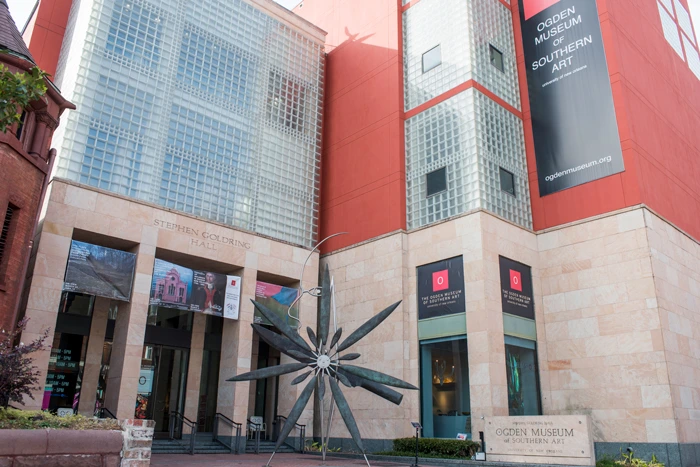
The American South has one of the richest and most distinctive artistic identities in the country—shaped by its complex history, cultural diversity, and deep ties to the land. Few institutions capture that story as powerfully as the Ogden Museum of Southern Art in New Orleans. With elegant gallery spaces, a standout gift shop, and lively after-hours performances, the Ogden offers a vibrant, immersive experience into Southern creativity.
Just steps from the former site of the Robert E. Lee monument, the Ogden looks forward, not back. It stands as one of New Orleans’ most engaging museums—beautiful, educational, and refreshingly unpretentious.
The centerpiece of the museum is Stephen Goldring Hall, a sleek glass-and-stone building with a soaring atrium that sets the tone for a thoughtful, uplifting visit. Opened in 2003, it houses the museum’s expansive collection of 20th- and 21st-century Southern art, the Museum Store, and the Center for Southern Craft & Design.
One of the architectural highlights is the museum’s floating staircase, connecting multiple levels. Pro tip: start on the top floor and work your way down—it’s the most efficient and easiest way to explore the galleries.
The museum’s origins trace back over 30 years, when New Orleans entrepreneur Roger Ogden and his father began collecting art as gifts for his mother. That hobby grew into a passion, and by the 1990s, Ogden had built one of the most important private collections of Southern art in the country.
Today, the museum that bears his name showcases an eclectic and ever-evolving range of works—from impressionist landscapes and outsider folk art to bold contemporary installations. As a Smithsonian affiliate, the Ogden also benefits from access to one of the most extensive collections in the world.
After soaking in the art, take a short walk to:
Carmo – a tropical café with fresh, globally inspired dishes in a relaxed atmosphere.
St. James Cheese Company – known for its artisanal cheeses and gourmet sandwiches, perfect for a casual, satisfying lunch.
Whether you’re a seasoned art lover or a curious traveler, the Ogden Museum of Southern Art offers a uniquely Southern perspective—honest, expressive, and full of soul.
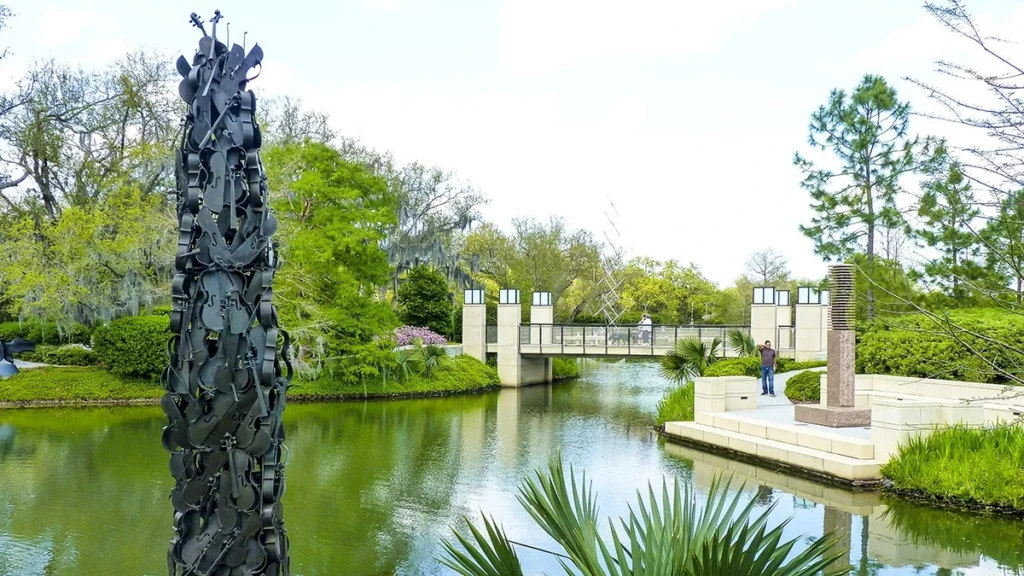
Nestled beside the New Orleans Museum of Art in City Park, the Besthoff Sculpture Garden is a serene tapestry of winding pathways, quiet benches, tranquil streams, and striking sculptures—mostly in the modern and contemporary style. Shaded by towering live oaks and draped in Spanish moss, it’s a peaceful escape that invites both reflection and discovery.
In the spring and summer, the garden often transforms into a venue for open-air theatre performances, but its charm endures year-round. Whether you’re an art lover, a romantic wanderer, or simply seeking a quiet stroll, this five-acre space offers a beautifully curated experience.
Among the highlights are three of George Rodrigue’s iconic “Blue Dogs”—rendered in red, yellow, and blue—playfully greeting visitors as they arrive. Opened in 2003 with works from the world-renowned Besthoff Collection, the garden now features over 60 sculptures by celebrated artists such as Antoine Bourdelle, Henry Moore, and Louise Bourgeois.
You could easily spend an entire day in City Park, especially if you’re drawn to both art and nature. Begin at the New Orleans Museum of Art, with its rich collection of regional and American works. Then, meander through the whimsical pieces in the Sculpture Garden, continue to the vibrant Botanical Gardens, and soak in the lush beauty of one of the largest urban parks in the country.
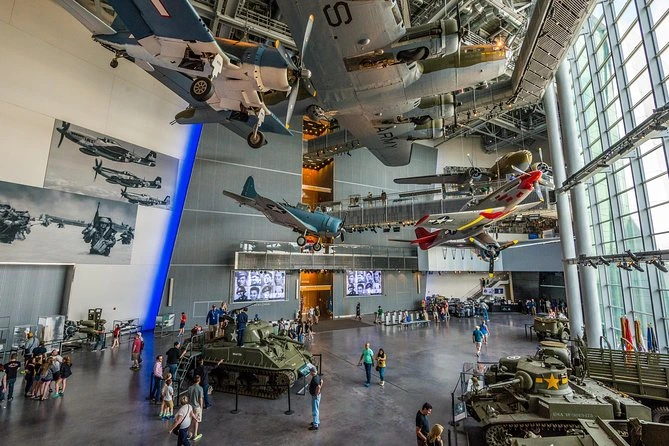
One of New Orleans’ most unique tourist attractions isn’t about food, music, or entertainment. Instead, it’s a museum dedicated to the United States’ role in the largest conflict in history—the National World War II Museum. Spanning several blocks in the Warehouse District, it was officially designated the nation’s World War II museum by Congress in 2003. The vast pavilions feature restored planes, tanks, interactive exhibits, displays of weapons, uniforms, and medals, along with films, newsreels, and immersive recreations of bunkers, ship bridges, forests, and jungles. Plan to spend at least half a day exploring the entire site.
The Campaigns of Courage
The museum is organized into multiple pavilions, each divided into various sections. The centerpiece for most visitors is the two “Campaigns of Courage” exhibits focusing on the European and Pacific theaters—the ‘Road to Berlin’ and the ‘Road to Tokyo.’ While the museum centers on American participation, it acknowledges other Allied nations mainly as supporting roles within the American story.
Highlights in the ‘Road to Berlin’ include a recreated Tunisian desert with authentic sand, gravel, a 1943 jeep, and a 105mm Howitzer. Another exhibit places you inside the snowy Ardennes forest during the Battle of the Bulge, leading into bombed-out city scenes of Cologne and Hamburg during the final push into Nazi Germany.
The ‘Road to Tokyo’ features a shark-faced P-40 Warhawk fighter plane, a detailed reconstruction of the USS Enterprise’s bridge where visitors can learn about naval battles and island-hopping campaigns, and a recreated jungle with towering palm trees reminiscent of Guadalcanal’s battlefields.
The Arsenal of Democracy
This section focuses on the war beyond the front lines. ‘Gathering Storm’ recounts the geopolitical tensions that led to the war and explains fascism as the driving ideology of the Axis powers. ‘A House Divided’ delves into deep domestic splits between American isolationists and interventionists. Other exhibits detail the massive mobilization of resources needed to fight a two-front war across the globe. The ‘United but Unequal’ gallery powerfully examines racial tensions at home—despite fighting ethnic nationalists abroad, the U.S. military remained segregated, and Japanese Americans were interned in camps.
The D-Day Invasion & Bayou to Battlefield
Originally known as the National D-Day Museum, this area now houses the core collection related to the June 6, 1944 Normandy landings. Here, visitors can see parts of the Nazi ‘Atlantic Wall,’ sand from the landing beaches, and numerous artifacts recovered from Normandy.
Why was the museum initially dedicated solely to D-Day, and why is it located in New Orleans? The answer lies with Andrew Jackson Higgins, a New Orleans boatbuilder who designed shallow draft vessels for local wetlands. His designs were adapted into the Landing Craft Vehicle Personnel (LCPV), the iconic landing boats used at D-Day and numerous other operations. A restored LCPV is displayed on site.
Beyond All Boundaries & Final Mission
Most visitors start their experience by watching the 45-minute “Beyond All Boundaries” film narrated by Tom Hanks, featuring immersive effects like falling snow and vibrating seats to simulate battle scenes. Another interactive exhibit, “Final Mission,” recreates the last voyage of the USS Tang submarine, which was sunk by a malfunctioning torpedo. This exhibit is housed in the US Freedom Pavilion, which also displays restored aircraft, tanks, and uniforms.
Tickets, Dining & Entertainment
The National World War II Museum is located at 945 Magazine Street. Paid parking is available at 1024 Magazine Street, though guests staying in the Warehouse or Central Business Districts might prefer to walk. The museum is open daily from 9 a.m. to 5 p.m. Admission costs $29.50 for adults, $18 for students, and is free for children under five. The “Beyond All Boundaries” and “Final Mission” experiences are $7 each. To avoid crowds, visit on weekdays outside the summer months, as weekends tend to be busy.
There are two onsite dining options: the Jeri Nims Soda Shoppe (8 a.m.–3 p.m.) offers a classic soda fountain atmosphere with lighter meals and coffee priced between $7 and $11. The American Sector serves traditional American fare from 11 a.m. to 2 p.m. on Sunday through Friday, and until 3 p.m. on Saturdays, with main dishes ranging from $8 to $13.
For entertainment, BB’s Stage Door Canteen presents lively 1940s-style stage shows, including performances by the all-female vocal group, the Victory Belles, who sing upbeat morale-boosting songs from the wartime era.
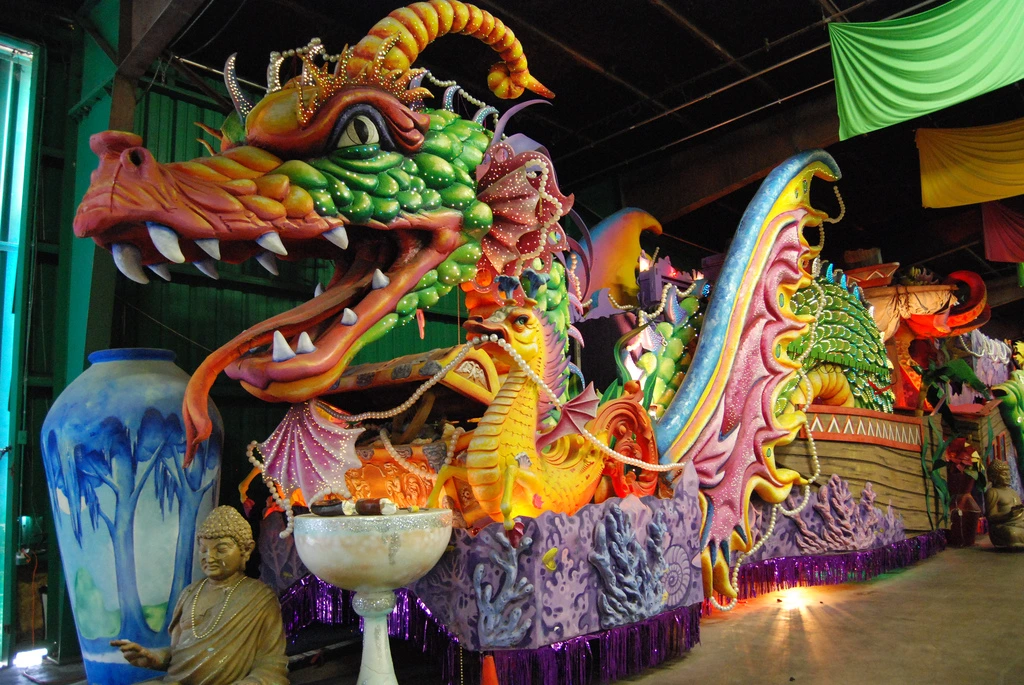
No celebration captures the spirit of New Orleans quite like Mardi Gras, the grand finale of a two-and-a-half-week carnival extravaganza. Few images are as iconic as the enormous, colorful floats filled with masked riders making their way down the city’s live oak-lined streets. For decades, the Kern family has been the creative force behind many of these spectacular floats, led by the late patriarch Blaine Kern. Today, Mardi Gras World—a sprawling 300,000-square-foot warehouse complex—showcases some of the family’s most dazzling creations, offering a glimpse into the magic unleashed during Mardi Gras.
Behind the Scenes in a Dreamlike Workshop
The Kern family reigns supreme in New Orleans’ float-building scene through Kern Studios, an entertainment design company that also creates installations for Walt Disney and the NFL. Yet, it’s Mardi Gras floats that established their fame, and Mardi Gras World is dedicated to those whimsical, larger-than-life masterpieces. While Kern Studios designs for other clients, those floats rarely capture the playful spirit seen on New Orleans’ carnival streets.
The highlight of Mardi Gras World is the “float den,” where the Kern team crafts new floats each year according to the themes of local parading groups known as “krewes.” In New Orleans (and some other Gulf South areas with Catholic carnival traditions), these krewes organize the parades. Instead of “marching,” krewes “roll” or “ride,” terms that reflect the massive floats carrying dozens of riders.
Each float must accommodate krewe members as well as bags of “throws” — items like plastic beads or stuffed animals that parade watchers eagerly try to catch, often shouting excitedly on chilly February evenings.
Visitors take a self-guided tour lasting about an hour, wandering through a warehouse filled with giant sculptures of fish, dragons, fairies, chimeras, neon flowers, pastel butterflies, and sometimes political or pop culture figures—creating a whimsical, almost surreal atmosphere.
A Brief History
In 1699, French-Canadian explorer Jean Baptiste Le Moyne Sieur de Bienville arrived at a site 60 miles south of New Orleans on the eve of Mardi Gras and named it “Pointe du Mardi Gras.” Since then, the holiday and city have been deeply intertwined.
Early Mardi Gras celebrations favored grand balls over parades, but processions became common by the late 19th century. Even into the 20th century, floats were simply wagons pulled by mules—until 1932 when sign painter Roy Kern and his son Blaine began building floats. Blaine founded Kern Studios in 1947 and, with his creative vision and determination, came to dominate float design in the city.
Having learned techniques in Europe, Blaine Kern blended the continent’s colorful float art with an American love for grand scale and motorized processions. His innovations led to today’s iconic tandem floats, flashy lights, and animatronics that define Mardi Gras parades.
Kern also expanded Mardi Gras beyond the city by selling floats to smaller and suburban krewes, creating a more diverse carnival season throughout greater New Orleans. Mardi Gras World has welcomed tourists since 1984 and has been in its current location near the Convention Center since 2008. Blaine Kern passed away in 2020, but his family continues to run the business.
Tickets, Parking & Getting There
Mardi Gras World is located at 1380 Port of New Orleans Place, next to the Convention Center. Parking is available for $20, but guests staying in the Warehouse or Central Business Districts may prefer to walk. A free shuttle also connects Mardi Gras World with central New Orleans.
The attraction is open daily from 9 a.m. to 5:30 p.m. Admission costs $22 for adults, $17 for seniors and students, and $14 for children.
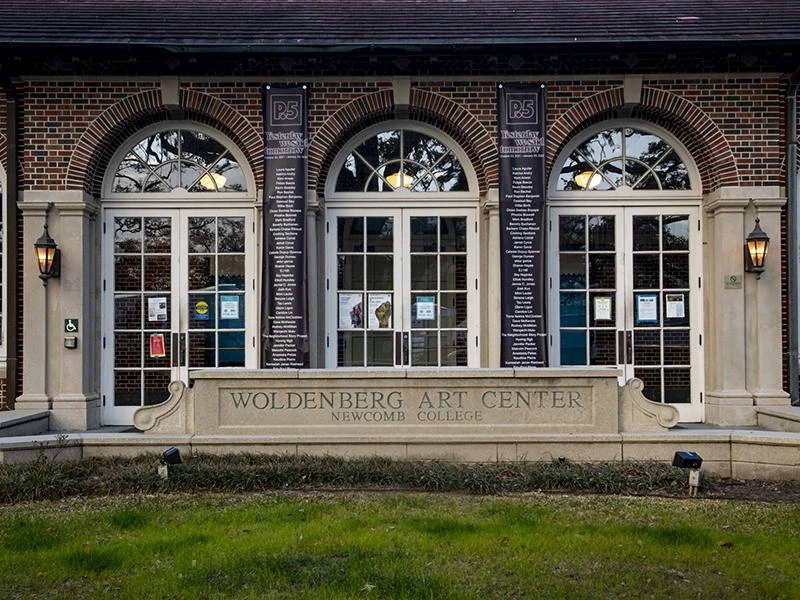
Situated within Tulane University and framed by stunning Tiffany stained-glass triptychs, the Newcomb Art Museum offers a wonderful place to enjoy a diverse art collection, ranging from colonial portraits to engravings by John James Audubon. Just outside the museum, a lovely green space invites students to relax, sunbathe, play Frisbee, and embrace the laid-back, joyful pace of American college life.

Tulane University’s campus is a picturesque scene of live oaks, red-brick buildings, and lush green quads spread over 110 acres near Audubon Park. Known as one of the country’s most beautiful colleges, it’s a great place to pause and stretch your legs if you’re riding the St. Charles Avenue Streetcar across town.
Tulane began with a unique mission—to combat yellow fever. Founded in 1834 as the Medical College of Louisiana to address recurring cholera and yellow fever outbreaks, it merged with the University of Louisiana in 1847. In 1883, philanthropist Paul Tulane’s generous $1 million donation spurred major growth and lent his name to the institution.
Today, Tulane enrolls about 13,500 students across 10 colleges and schools. Its law school is well known, especially during exams when students fill cafes along Magazine Street. The medical school, now located downtown, also enjoys a strong reputation. Notable alumni include former French president Jacques Chirac, politician Newt Gingrich, TV host Jerry Springer, and numerous Louisiana governors, judges, and other public figures.
The Amistad Research Center holds over 15 million documents, making it one of the nation’s largest collections of African American history. While it’s not a museum, a small exhibit area on the second floor rotates displays offering rare insights into ethnic heritage. Past exhibits have featured artifacts from the Negro Baseball League and works from the Aaron Douglas Collection.
Music lovers will appreciate the Hogan Jazz Archive, which houses New Orleans jazz memorabilia including sheet music, photos, journals, and recordings. Though most materials are not on permanent display, staff can assist visitors in accessing treasures like 78rpm records dating back to 1917, including early recordings by the Original Dixieland Jazz Band. Nearby, the Southeastern Architectural Archives highlight regional designs, with recent exhibits focusing on Gulf Coast bungalows.
Art enthusiasts can visit the Newcomb Art Museum, framed by stunning Tiffany stained-glass triptychs. The museum typically showcases local and regional artwork. Just outside, a vibrant green space invites students to relax, sunbathe, play Frisbee, and soak up the joyful rhythms of college life.
WhatsApp us